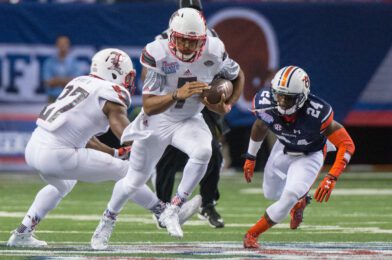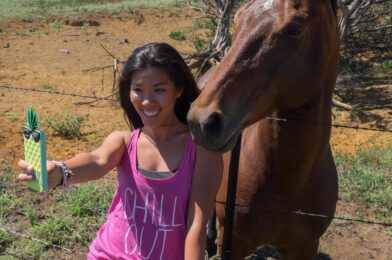| Nikon D4, Sigma 120-300mm ƒ/2.8 DG OS HSM | S, Sigma TC-2001 2x, ISO 12800, ƒ/5.6, 1/1250 |
I wanted to share some photos I captured from the Chick-fil-A Kickoff this year, where Auburn defeated Louisville 31 to 24.
 |
| Nikon D4, Sigma 120-300mm ƒ/2.8 DG OS HSM | S, Sigma TC-2001 2x, ISO 12800, ƒ/5.6, 1/1600 |
There are a couple of things that helped me get some of what I thought were lovely moments.
Camera Settings: To see these go to the blog post on them here
- Custom White Balance with ExpoDisc
- AUTO ISO
- ISO range 100 – 12800 on Nikon D4
- Minimum Shutter Speed 1/2000 – The shutter will drop below 1/2000 once the ISO maxes out at ISO 12800
- Continuous High Shutter Release
- Focus
- Continuous
- Focus Point Selection – 21-point dynamic-area AF
- Focus Tracking with Lock On set to 4
- AF activation and choose “AF-ON only.” This setting will not focus on the lens when I press the shutter. Instead, it will only fire the camera.
- To focus, I am using the AF-ON button on the back of the Nikon D4.
 |
| Nikon D4, Sigma 120-300mm ƒ/2.8 DG OS HSM | S, Sigma TC-2001 2x, ISO 12800, ƒ/5.6, 1/2000 |
A few other photographers used to shooting night games at the Georgia Dome were using their teleconverters since this was a daytime game. The arena has a large white sheet over the dome, giving a diffused daylight across the field.
 |
| Nikon D4, Sigma 120-300mm ƒ/2.8 DG OS HSM | S, Sigma TC-2001 2x, ISO 12800, ƒ/5.6, 1/1000 |
The lights they use for night games were also on for the game. So my White Balance was 4250º Kelvin and +29 Magenta.
 |
| Nikon D4, Sigma 120-300mm ƒ/2.8 DG OS HSM | S, Sigma TC-2001 2x, ISO 12800, ƒ/5.6, 1/1600 |
I enjoy shooting from the end zone as much as possible, so using the Sigma 120-300mm ƒ/2.8 DG OS HSM | S with the Sigma TC-2001 2x gave me a 240-600mm ƒ/5.6 lens.
It was ultra quick to lock in on focus and track players as they moved across the field.
 |
| Nikon D4, Sigma 120-300mm ƒ/2.8 DG OS HSM | S, Sigma TC-2001 2x, ISO 12800, ƒ/5.6, 1/1250 |
In the photos you are seeing, I was tracking the play and would start shooting just about the time, say a pass was to hit their hands, and motor drive through in case anything like a missed catch could happen.
 |
| Click on the image to see a larger version. |
Here is the take on that particular image above. Every one of the images was sharp and usable.
 |
| Nikon D4, Sigma 120-300mm ƒ/2.8 DG OS HSM | S, Sigma TC-2001 2x, ISO 12800, ƒ/5.6, 1/1000 |
Before the “Big Game,” shoot the “Small Game.”
I recommend going to the community recreation center in your town or local high school, shooting with the same gear, and getting used to it. Then, if you rent a camera or lens, pick it up so maybe you can squeeze in a Friday night game before the “Big Game” on Saturday or Sunday.
Missed shots are more related to how well you know your gear than anything else. Be sure you are getting all you can out of the equipment. Please don’t blame the equipment when it might be your knowledge of how to use your gear that is the problem.










